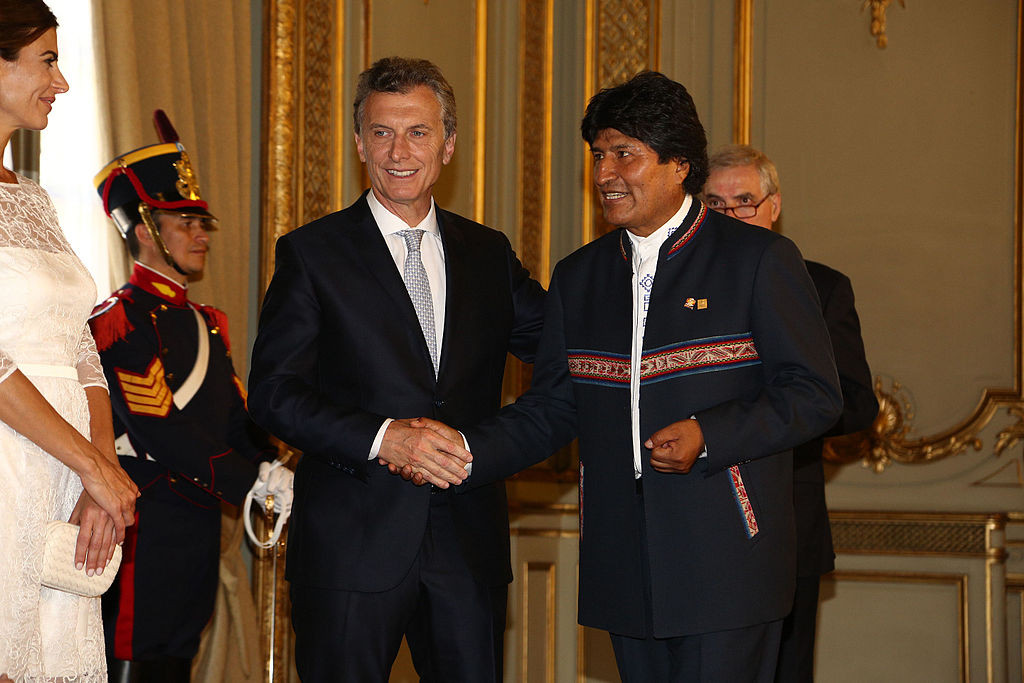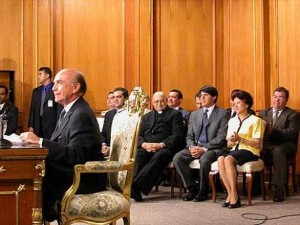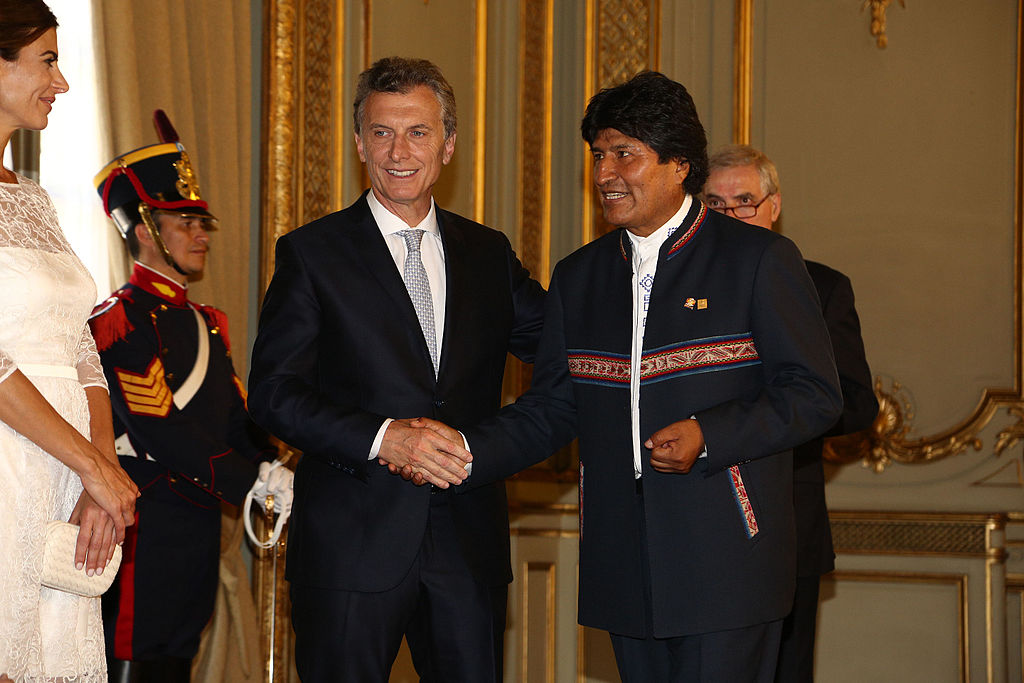by Christopher Wylde, Associate Professor of International Relations at Richmond University and Visiting Fellow at ILAS
The so-called ‘Pink Tide’ that swept Latin America from 1998 onwards has recently experienced a number of electoral challenges, which complement previous mobilisational and extra-constitutional challenges. In the hubris of the mid-2000s, the Left looked unassailable across large swathes of Latin America. Hugo Chávez was re-elected for a third time in 2006; Chile was under the administrations of Ricardo Lagos and Michelle Bachelet, who had run proceedings throughout the long decade, with only a brief interregnum from the centre-right in the form of Sebastiá Piñera. Brazil had elected Lula for a second time in 2007; Argentina was dominated by the Kirchners; Evo Morales and the MAS were triumphant in Bolivia; Correa in Ecuador, Vásquez in Uruguay, Colom in Guatemala, Funes in El Salvador, even Paraguay under Lugo (albeit briefly) – the list is long.

Mauricio Macri y Evo Morales, by Gastón Cuello, CC BY 2.5 AR
Fast-forward to 2016 and the situation is not so rosy for the Latin American Left. The election (by a wafer-thin margin) of the right-wing, market-friendly Mauricio Macri in Argentina has heralded an end to Kirchnerismo and its neo-developmentalism and the attendant rise of a distinctly more neoliberal flavour to Argentine governance. Significant changes have already occurred in Argentina’s political economy of development, manifested in policy changes ranging from a sharp depreciation of the peso, capitulation to global capital markets in the form of paying the fondos buitres (vulture funds), an immediate reduction of retenciones (export taxes) for large agricultural Trans-National Corporations (TNCs), and a ‘sudden-stop’ to domestic energy subsidies.
Meanwhile, in Latin America’s largest and most populous economy, the hydra-headed Petrobras scandal has engulfed even Lula himself, with former President Dilma Rouseff being removed from office through impeachment proceedings in Congress – what Barry Cannon of NUI Maynooth has termed a ‘smart coup’. Nicolás Maduro – Chávez’s successor in Venezuela – has undoubtedly been hurt by a slump in oil prices, with an alliance of centre-left, centrist, and right-wing opposition parties scoring a resounding victory in parliamentary elections in December 2015.
Understanding the Right (in Latin America)
In order to get to grips with what these shifts mean for Latin America and its contemporary development trajectory we first need to understand and map the contours of the left/right divide (in Latin America). Impressive and detailed primary research on this topic by Dr. Barry Cannon from NUI Maynooth provides valuable insight. In his newly published book The Right in Latin America (Routledge, 2016) he proposes that an analysis of inequality generates a powerful ontology of Right/Left politics in Latin America. Policy solutions may change, but this central concern is constant. For the Left, this translates into greater state involvement in the market in order to ensure more substantive equality through welfarism; for the Right this means greater state involvement in the market to enforce pro-market regulations designed to enhance equality of opportunity.
These public-policy profiles have implicit and explicit outcomes favouring some class fractions over others, meaning that class and the role of elites should be central to any discussion of the Right. Historically, political parties of the Right in Twentieth Century Latin America were not prominent in its political expressions. Domination of the state through personal, bureaucratic, and clientelistic ties obviated the need for direct control of the main organs of government (executive, legislature, federal governors where relevant). Betrayal of these elite interests in the form of Import Substituting Industrialisation (ISI) led them to turn to the military in the 1970s and early 1980s – ushering in what Guillermo O’Donnell termed Latin America’s ‘bureaucratic-authoritarian’ period. The lack of economic success of these regimes, combined with the decline of the militant left across the region, ushered in democratic transitions, so as the 1980s progressed the Right embraced democratic politics and a renewed emphasis on parties, legislatures, and elections.

Coup leader Pedro Carmona and various supporters, Palacio Miraflores, Caracas, 2002
This analysis reveals that the Latin American Right goes far beyond political parties. Institutions like the Church and the Media, as well as socio-economic elites in large firms or think-tanks, must all be considered as part of the nexus of Right power. In summary, all those class fractions, institutions, and actors of society that support the free market and a lessening of state power over market relations (in order to fulfil its desire for equality of opportunity – read: equality to engage in market based relations) come under the aegis of the Right.
This means that an understanding of the contemporary Right in Latin America must incorporate analysis of not only political parties, but also the way in which power is exercised beyond this arena. With this in mind, the rise of the Right and the ways in which they have resisted the Pink Tide must be understood not only in terms of electoral politics, but also mobilisational and extra-constitutional tactics as well. Therefore, the election of right-wing government (in particular Argentina) must be understood alongside mass demonstrations in Brazil, for example, as well as extra-constitutional practices such as the attempted coup d’état in Venezuela in 2002.
The influence of the Right in Contemporary Latin America
With this in mind, the return of the Right to Latin American politics is a somewhat misleading starting point as the Right never really went away. This is especially true in the broader context of Latin America’s insertion into the global division of labour. Given that the structures of international political economy distinctly favour pro-market regulation and its associated suite of policy prescriptions (privatisation, liberalisation, and de-regulation), the contours of the Pink Tide itself were fundamentally shaped by this dynamic. As a result of what José Santiso termed the ‘limits of the possible’ the post-neoliberal modality of governance emphasised by Pink Tide states had a strong neoliberal flavour: private property was not systematically attacked – there was no significant land redistribution; free trade was largely maintained – albeit with certain protections for strategic sectors; macroeconomic frameworks remained largely in line with servicing international debt obligations; and poverty-reduction programmes were firmly embedded in a neoliberal discourse of Conditional Cash Transfer (CCT) principles (Bolsa Familia, AUH, Bono Solidario etc.). This was tempered with a more active industrial policy, a refreshed neo-corporatism, a moratorium on privatisations (with some re-nationalisations), and the construction of counter-hegemonic regionalism (ALBA, UNASUR, and CELAC), combined with an attempt to forge a new social contract between the state and the people through a reconceptualization of citizenship.
In its totality this post-neoliberal governance represented a crystallisation of previous forms of political economy – including the neoliberalism of the 1990s and the ISI period of the mid-twentieth century. As a result, the ‘return of the right’ – to electoral politics at least – should not be overemphasised, as the Right’s power in Latin American political economy beyond the state has always shaped political discourse, even at the apex of Pink Tide power.
Yet, the case of Mauricio Macri in Argentina clearly demonstrates that the return of the Right to electoral politics has had an important impact on Argentina’s development trajectory. His early policies represent an attempt to re-orientate Argentine political economy towards a full-blooded neoliberalism, thus conforming to a pro-market ideology that emphasises equality of opportunity. However, equally interesting are those aspects of the post-neoliberal Argentine state that Macri is not changing: the state oil company YPF remains nationalised and the core poverty alleviation programme (AUH) remains in place. This acceptance of the need to provide for the poor goes beyond the elites of Argentina and represents an important shift in the thinking of the Right in Latin America in general.

Asignación Universal por Hijo en Mar del Plata, by Casa Rosada, CC BY-SA 2.0
In an interview before her death Margaret Thatcher said that her greatest legacy to UK politics was Tony Blair, the implication being that her administrations had shifted British politics fundamentally to the right, so that even a left wing Labour Prime Minister now pursues essentially Right-wing policies (understood in terms of equality of opportunity). In this vein, and given Argentina’s current commitment to the anti-poverty rhetoric and policies of the post-neoliberal regime of the Kirchner’s, perhaps Cristina’s (and Néstor’s) greatest legacy will be Mauricio Macri.


Recent Comments